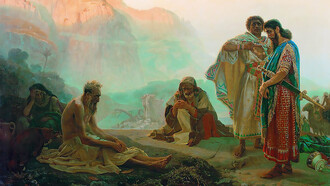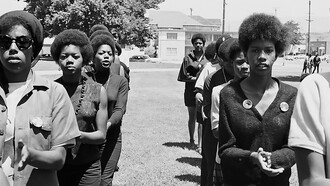On August 21-22, 1831, Nat Turner led the most successful slave revolt in United States history and demonstrated the overt resistance to enslavement. In Southampton, Virginia, Turner and his fellow rebels killed 55-60 white men, women, and children as they made their way to Jerusalem, Virginia. The rebellion was defeated when it encountered organized resistance. Turner was captured on October 30 and executed on November 11, 1831.
Who was Nat Turner?
Nat Turner was a literate enslaved man who was deeply religious. He read the Bible, fasted, and was a “Prophet” by those to whom he ministered. Most critically, both his mother and grandmother believed he was destined for a great purpose in life.
What inspired Turner’s revolt?
From childhood, Nat Turner was being prepared for his role as a “Prophet” and General of a rebellion against enslavement. He was influenced by his mother’s hatred of slavery, his father’s running away, and the stories he heard from his mother and grandmother of his connection to his African heritage and African warriors.
Several more recent personal factors could have inspired Turner’s revolt. His family was separated and sold on two occasions, and his son was to be used as collateral for the slaveowner's debt. Imagine the pain and grief of separation from one’s family. However, it was Nat’s belief in his calling, inspired by his mother’s connection to her African roots, his African connection to nature, prophetic visions, and his goal to not only secure his own freedom but to liberate all enslaved and dismantle the system of slavery.
The mythology of enslaved
The myth of the happy slave justified enslavement by slaveholders and defenders of the institution of slavery. The enslaved were believed to be content, enjoying and flourishing in bondage. They were seen as naturally suited for servitude ( even described in the Bible), childlike and incapable of thinking and self-determination. Most inhumane, the enslaved were believed to be incapable of human feelings and emotions. Those who expressed unhappiness and defiance were seen as an aberration and suffering from a mental disease as opposed to having a human reaction to their bondage.
Contrary to slaveholder beliefs, the enslaved did engage in day-to-day resistance without violence, according to Bauer and Bauer in Day to Day Resistance to Slavery in American Slavery, in The Question of Resistance (1971.) They engaged in work slowdowns, destruction of property, malingering, feigning illness and pregnancy, suicide and infanticide. The enslaved engaged in hypocrisy, “wearing the mask of the subservient” to resist as well. Because they were believed to be ignorant of feelings, character, and capacity, they used the “cloak of stupidity” expected of them to trick, engage in theft ( I worked for it, it belongs to me.), and indifference, regarded by slaveholders to be laziness and stupidity.
Critically, they displayed the outer self by cheerfully obeying and guarding the inner self of true human feelings. The dancing and singing that slaveholders viewed as happiness was, in actuality, an underground culture based upon African traditions of storytelling, singing, and dancing that affirmed their humanity and even allowed for the making of secret plans for resistance and running away.
While both Gabriel’s and Denmark Vesey’s rebellions had been betrayed, Nat Turner’s revolt brought the truth of the feelings of the enslaved to light. Like the previous plans for rebellion, Nat used the Bible, the instrument of control for the enslaved, as a tool of revolution.
The aftermath of Nat Turner’s revolt
Whites, infuriated by the rebellion and fearful of the enslaved, engaged in the wholesale slaughter of over 200 Blacks who were not connected to the rebellion. White mobs whipped, tortured, lynched, and decapitated Blacks whose heads were mounted on poles alongside roads. In addition, legislation was passed that prohibited the education of Blacks, their movement, and assembly of enslaved people.
Why has Turner been demonized and his revolt hidden from history?
Nat Turner was the nightmare of slaveholders and those who believed in white supremacy. He caused an unparalleled wave of cognitive dissonance as his rebellion shattered the mythology of the happy, contented enslaved, as well as the mythology that the enslaved were without human emotions. As much as the killing of whites was the grievous crime of destruction of white supremacy doctrine that led to the sociopathic rampage as retribution that followed against all blacks. Nat’s rebellion demonstrated that just as the slaveholders used violence to control and instill fear in the enslaved, the enslaved would use violence to secure their freedom.
Why should Nat Turner’s Revolt be remembered and taught as United States history?
There is but one historic marker on Virginia State Route 30 in Virginia that recognizes the Nat Turner Rebellion. Turner is not written about and discussed in history books, not even during Black History Month. His revolt has been described as “fanatic, vindictive, and without cause or provocation” in the Richmond Enquirer, August 30, 1831.
Did Nat Turner have the right to use any means necessary to secure the freedom of his people? Should Nat Turner be considered a revolutionary hero, as were the patriots who used violence against the British to attain their freedom? Do the enslaved have the right to feel and act upon human feelings, including anger, contempt, hatred, and rage? What humans should have the right to use violence to achieve personal and social freedom? Finally, should “ Black August” be celebrated to mark the anniversary of a freedom fighter’s courage and determination to achieve freedom and equality for his people?















